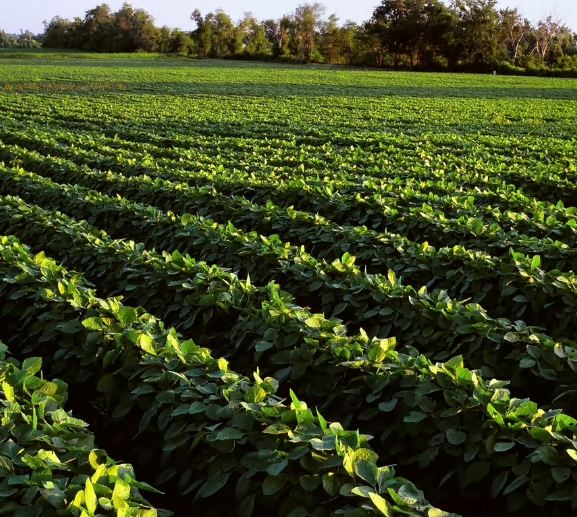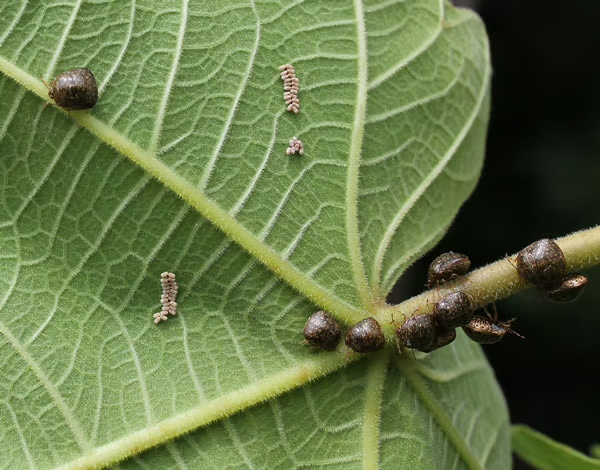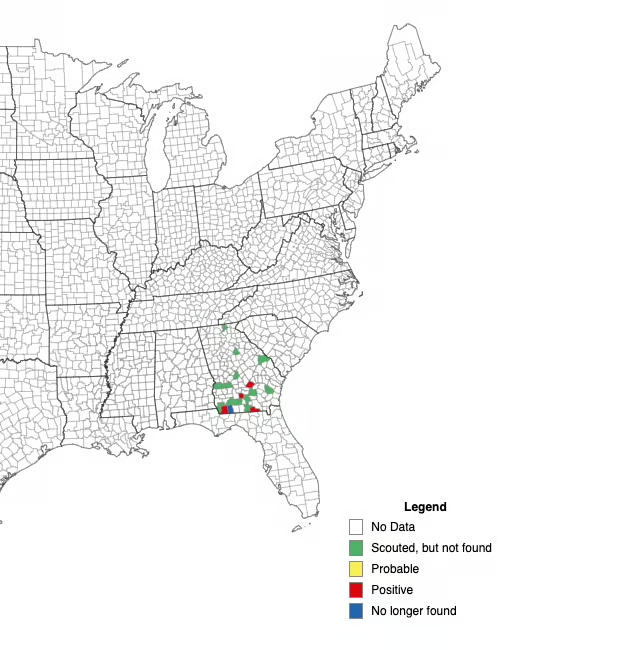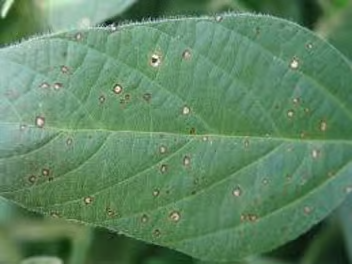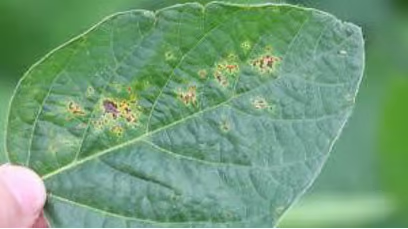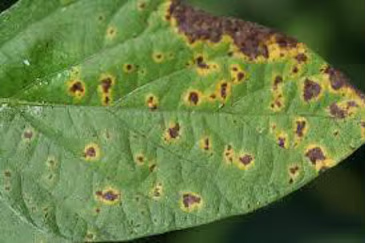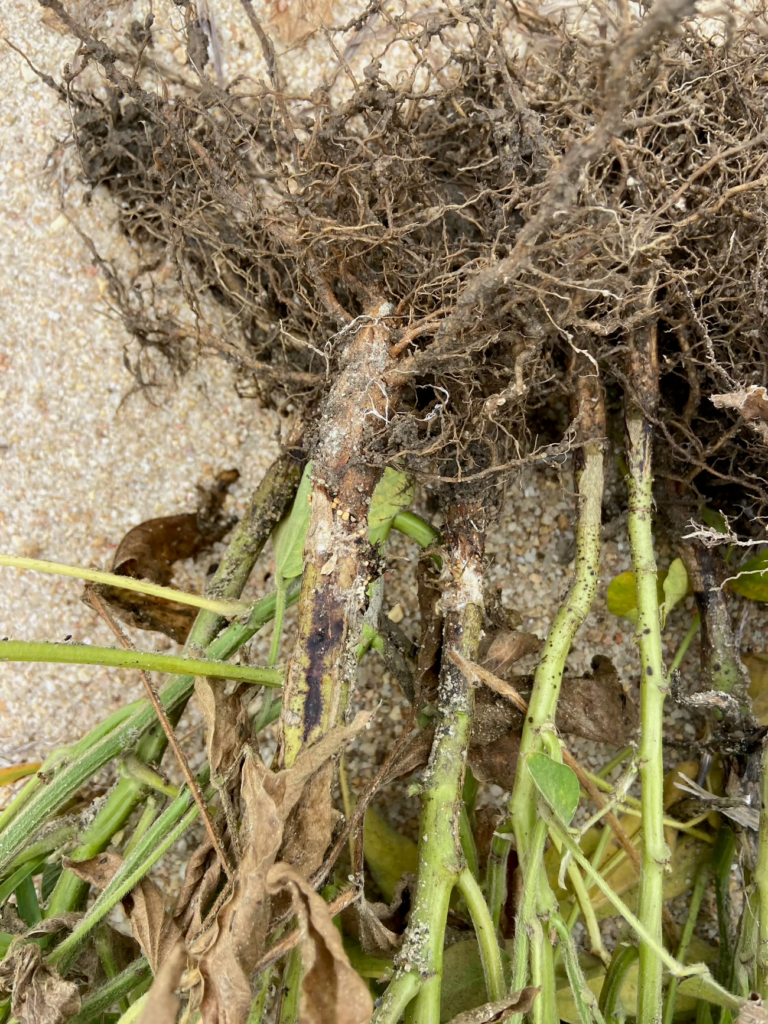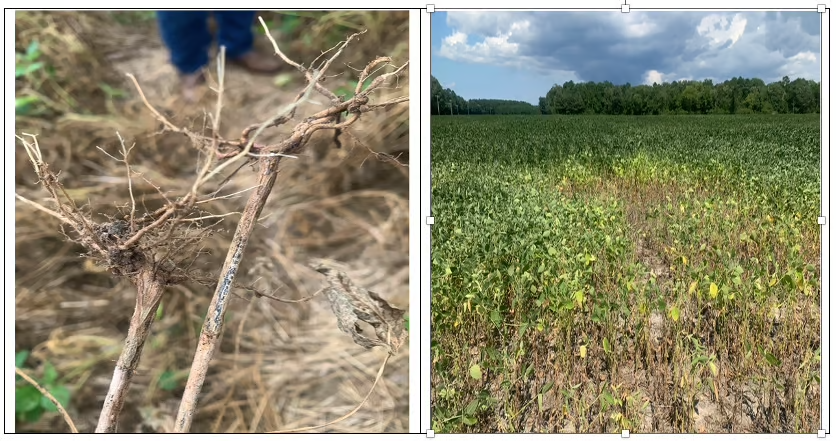2024 Soybean Insect & Disease Control
go.ncsu.edu/readext?1016634
en Español / em Português
El inglés es el idioma de control de esta página. En la medida en que haya algún conflicto entre la traducción al inglés y la traducción, el inglés prevalece.
Al hacer clic en el enlace de traducción se activa un servicio de traducción gratuito para convertir la página al español. Al igual que con cualquier traducción por Internet, la conversión no es sensible al contexto y puede que no traduzca el texto en su significado original. NC State Extension no garantiza la exactitud del texto traducido. Por favor, tenga en cuenta que algunas aplicaciones y/o servicios pueden no funcionar como se espera cuando se traducen.
Português
Inglês é o idioma de controle desta página. Na medida que haja algum conflito entre o texto original em Inglês e a tradução, o Inglês prevalece.
Ao clicar no link de tradução, um serviço gratuito de tradução será ativado para converter a página para o Português. Como em qualquer tradução pela internet, a conversão não é sensivel ao contexto e pode não ocorrer a tradução para o significado orginal. O serviço de Extensão da Carolina do Norte (NC State Extension) não garante a exatidão do texto traduzido. Por favor, observe que algumas funções ou serviços podem não funcionar como esperado após a tradução.
English
English is the controlling language of this page. To the extent there is any conflict between the English text and the translation, English controls.
Clicking on the translation link activates a free translation service to convert the page to Spanish. As with any Internet translation, the conversion is not context-sensitive and may not translate the text to its original meaning. NC State Extension does not guarantee the accuracy of the translated text. Please note that some applications and/or services may not function as expected when translated.
Collapse ▲Information on Insect and Disease Control in Soybeans
I have caught stink bugs and kudzu bugs in the sweep net and on the beat cloth. Kudzu Bug and eggs are pictured above. We have not reached a threshold in any field, but we need to watch for this pest.
Kudzu Bugs
Stink Bugs
| Row Width | 7 | 15-24 | 30-40 | Production |
| Beat Cloth | 5 | 5 | .5 | Grain |
| Sweep Net | 2.5 | 2.5 | 1 | Seed |
Soybean Podworm Complex and Resistance
Disease Control
It is always highly recommended that soybeans be planted that are resistant to as many soybean diseases as possible in your planting area. Wet and humid weather and cool and humid weather can often lead to foliar and stem diseases in soybeans. I have included the latest update from the Asian soybean rust site and a link to the updated maps. I assume that the maps will be updated in the next few days as sentinel plot data is reported.
Soybean Rust
(Phakospora pachyrhizi )
Although soybean rust can cause defoliation and significant yield loss, the pathogen does not overwinter in North Carolina. The alternate host for soybean rust is kudzu; however, environmental conditions during the winter months in North Carolina generally prevent overwintering from occurring. Each year, inoculum disperses northward, and inoculum is tracked using the Soybean Rust IPM Pipe. Cool, wet weather with prolonged leaf wetness (more than 6 hours) allows for spore germination, and conditions with high humidity encourage disease development after establishment.
Symptoms. Rust lesions are tan to reddish-brown and may occur on any green surface of the plant. Lesions contain one to three pustules that are raised on the leaf surface.
Lesions may have an angular shape and may be confused with bacterial pustule lesions. Placing leaves in a bag with a moistened paper towel for 24 hours may cause pustules to erupt and expose spores. Infected plants may defoliate early and have smaller seeds. If you suspect that rust may be present in your field, contact your county Extension agent to send samples to the North Carolina State University Plant Disease and Insect Clinic for confirmation.
Management. There are no rust-resistant soybean varieties commercially available in North America. When rust is found within 100 miles of a field, foliar fungicides may be necessary to manage the disease. To adequately control rust, fungicides must be applied before or soon after the first infection. Foliar fungicides applied between R3 and R5 may reduce the level of disease.
Based on data from NC State, making a fungicide application can produce a profit, but choosing the right product at the right time can make or break profits in any given year.
Please see the 2024 Ag Chemical Manual for recommendations.
Other foliar diseases in our area that cause issues are Frogeye Leaf Spot, Cercospora Blight, Bacterial Blight, and Brown spot. It is always RECOMMENDED to check for variety resistance before spraying.
Frogeye Leaf Spot
(Cercospora sojina)
Frogeye leaf spot is primarily a foliar disease of soybean but is capable of being seed-borne. Disease epidemics can become severe if infected seeds are planted or if soybeas are planted following a disease epidemic in the previous growing season. The fungus survives in infested crop residue, and continuous soybean fields may be more affected due to the persistence of inoculum.
Symptoms. Lesions on leaves may be circular or angular, gray spots with reddish- purple margins. These spots are first visible on the upper surface of the leaf. As lesions age, the centers become gray or light brown, sometimes with small dark spots in the center. Lesions may coalesce to form larger, irregular spots. Heavy infestations may lead to premature defoliation of the plant. While young leaves are most susceptible to infections, lesions may not be visible until leaves mature because it takes several weeks for lesions to develop.
Under persistent heavy rainfall or humidity, stems and seeds may also become infected. Stem lesions appear as narrow, brown lesions that become light gray with dark margins as the lesions mature. Lesions on pods are initially circular and red-brown and become gray with a dark margin.
Management. Planting resistant varieties or certified disease-free, high quality seed are the best mechanism for preventing disease outbreaks. Continuous soybean rotations also promote significant buildup of residues, and should be avoided. If planting soybean following a year with frogeye leaf spot infestation, plant a resistant variety. Foliar fungicides may be warranted where there are favorable environmental conditions and susceptible varieties. Strobilurin-resistant Cercospora sojina populations have been detected in several counties of North Carolina, and using a pre-mix fungicide with multiple modes of action may help prevent losses of control.
Cercospora Blight and Purple Seed Stain
(Cercospora kikuchii)
Cercospora blight accounts for 0.3% of yield losses caused by foliar pathogens in North Carolina and can cause significant damage under warm, wet conditions. When the seed becomes infected, causing a purple seed stain, the value of the crop may be reduced.
Symptoms. Initial signs of infection are found in the upper canopy on young leaves during pod-filling stages and into maturity. Affected leaves show irregularly shaped patches of purple to bronze discolorations, typically only on the leaf surface, resembling sunburn. Severe infections may result in premature defoliation of the uppermost leaves, while lower leaves remain green and attached to the plant.
When seeds are affected, a purple to pink discoloration may occur in small spots on the entire surface of the seed. Infected seeds may also show no symptoms of infection.
Seedlings from infected seeds will show symptoms of the disease, causing cotyledons to turn purple, shrivel, and drop. Stem lesions may also form on seedlings, which can girdle and kill the seedling. Seedlings that survive produce stunted plants and limit yield potential.
Management. Combining cultural practices and host resistance will provide the best control of this disease. Promoting airflow and good soil drainage may help reduce the incidence of Cercospora blight. Crop rotation and residue management, such as tillage to promote rapid crop residue decomposition, will also help minimize inoculum build-up from previous soybean crops. Choose more resistant varieties and plant-certified, disease-free seeds. Fungicides are not generally recommended, and no fungicides are labeled with high efficacy.
Bacterial Blight
(Pseudomonas syringae)
Pseudomonas syringae causes angular leaf spots and bacterial blight, which usually causes minimal damage in North Carolina. More severe outbreaks are associated with heavy rainfalls and winds. Infections occur through natural openings in the plant or wounds, such as those caused by hail or cultivation. High temperatures often slow or stop the development of the disease.
Symptoms. Young leaves are most susceptible to infections, and leaf spots may appear on any portion of the plants. Lesions are often small, angular, and brown to red-brown with a water-soaked margin. A yellow halo usually surrounds the margins. Lesions will continually grow together to produce large, irregularly shaped necrotic leaf areas, the centers of which frequently fall out. On stems and petioles, lesions are large and black but do not share the angular margins of leaf infections.
Management. While complete resistance to bacterial blight is unavailable commercially, a difference in tolerance has been observed in the field. Selecting a variety with some tolerance to bacterial blight may reduce incidence where there is a history of angular leaf spot and bacterial blight. Crop rotation and tillage to reduce the survival of inoculum may aid in limiting infections.
Septoria Brown Spot
(Septoria glycines)
Septoria brown spot causes 0.5% of yield losses in North Carolina soybean production and can be found throughout the growing season. Warm, wet weather favors disease development, and dense plantings in the lower canopy also favor disease development.
Symptoms. Lesions are small, irregularly shaped, and dark brown and can be found on all leaf surfaces. Adjacent lesions can merge to form large, irregularly shaped brown spots. Infected leaves quickly turn yellow and drop. The disease typically begins in the lower portion of the canopy and, under favorable conditions, progresses into the upper parts of the canopy.
Management. Crop rotation and tillage reduce inoculum availability. Other legume species are hosts, so crop rotations should include non-leguminous plants like corn or small grains. Foliar fungicide applications may be warranted under conducive environmental conditions, and the efficacy of different modes of action is essential to rotate each production season. Applications made between R3 and R5 may slow the rate of development to protect yield.
Soilborne Diseases appearing late season
Southern Blight
(Athelia rolfsii)
Symptomatology associated with southern blight includes yellowing, wilting, light brown lesions on stems near the soil surface, and white fan-like mat of hyphae. This pathogen favors hot, wet weather conditions. Deep cultivation to bury sclerotia and crop rotations to non-host crops such as wheat or corn are the best management practices. Fungicides are not recommended.
Phytophthora
Although phytophthora is an early-season disease, symptoms frequently appear in the late season in moist soil conditions. Early symptoms include poor stand and dying seedlings may have missing or soft, brown rotted roots. Symptoms found later in the season include stunting, stem and root rot, and development of brown stem canker that can cause girdling. When the stem is transversely cut, vascular tissue and cortex have brown discoloration. Leaves will later become chlorotic and wilted if the infection is severe. Phytophthora sojae generally grows rapidly in warm, wet soil conditions.
Stem Canker on Soybeans
Symptomatology associated with soybean stem canker can include reddish-brown lesions on the main stem at the base of a lower stem, small black spots that appear on dead tissue, and dead leaves that remain attached to the stem. There are no options to remedy this issue during the season; however, you can best manage this disease with resistant varieties and crop rotation to non-host crops such as corn or wheat. Fungicides are typically reported to have little to no efficacy when managing stem canker.
Nematodes
Soybean cyst nematode (SCN)
Soybean cyst nematode (SCN) has been the most severe disease in North Carolina. It is found in all soybean-producing regions of the state, and severe losses are especially common in sandy, coastal plain soils. Cool to moderate conditions with adequate moisture tend to enhance SCN reproduction and favor spread. At the end of the growing season, the female nematodes form cysts that allow egg masses to overwinter until a susceptible host is available, contributing to the inoculum in future growing seasons.
Symptoms. Symptoms of SCN can be easily confused with herbicide injury or nutritional disorders. SCN is characterized by irregular patches of stunted soybeans, yellow soybeans, or both. A yield decline can be observed over several years in fields affected by SCN. Failures in weed control may also be indicative of SCN infections. Observing cysts on the roots of affected plants may also be possible. Young cysts will be white to yellow and about the size of the tip of a ballpoint pen. Older cysts will be dark brown, making them more challenging to see.
Lesion nematodes
Roundworms that require living plant roots to feed and reproduce. They can cause necrotic lesions on the roots, predispose the roots to further infection, and mimic nutrient and drought stress.
Symptoms. Reduced vigor, stunting, and chlorosis (yellowing) are common symptoms of lesion nematode. Feeding damage by this nematode produces small black and brown necrotic lesions (spots of dead tissue) along the root. In severe cases, the root’s outer layer may slough off, exposing the inner part.
Root knot nematode
Caused by plant parasitic nematodes belonging to the genus Meloidogyne, including southern root knot, guava root knot, Javanese root knot, northern root knot, and peanut root knot. Southern root knot nematode is the most prevalent root knot species in North Carolina.
Symptoms. Reduced vigor and stunting of plants are the first indications of root-knot nematode pressure. Infected plants wilt more rapidly under hot, dry conditions than unaffected plants. Severely affected plants show stunting and chlorosis due to nutrient and water deficiency. These plants may die before maturity and fail to produce seed. Roots of affected plants have irregular deformations (galls, knots, or bumps along the root) that contain the adult female nematodes. As opposed to beneficial root nodules, root-knot nematode galls are not perfectly round and cannot be removed from the roots.
Stubby-Root Nematode
Several species of stubby-root nematode are found in North Carolina. These nematodes have a broad host range, including soybeans, cotton, corn, peanuts, small grains, potatoes, and other vegetables. Although these nematodes can occur in various soil types, damage is frequently more severe on sandy soils.
Symptoms. Reduced vigor and stunting are common symptoms of stubby-root nematode. Feeding damage by this nematode may result in “stubby” or stunted roots accompanied by brown lesions.
Sting Nematode
Sting nematodes can cause severe losses when present. This nematode has a low threshold, meaning that impacts can be high even when population counts are low. The sting nematode is generally limited in distribution to sandy and coarse-textured soils, so soil sampling and monitoring on these soils are important. Host crops of this nematode include soybeans, cotton, corn, peanuts, small grains, and numerous vegetables.
Symptoms. Stunted plants and poor stands are common symptoms of sting nematode. Feeding damage produces stubby or stunted roots with small black spots or lesions. Roots may try to outgrow the feeding damage, resulting in the appearance of an overly branched root system.
Nematode Management.
Combatting other production limitations, such as soil fertility and hardpan, may curb the impact of nematode infestations. Several nematicides and seed treatments are labeled for use in soybeans, but they are often not economical, and their efficacy may be short-term. Crop rotation and host resistance still appear to be the best ways to combat these pests.
Regular soil sampling will help determine the level of risk sting nematode poses to a soybean crop.





